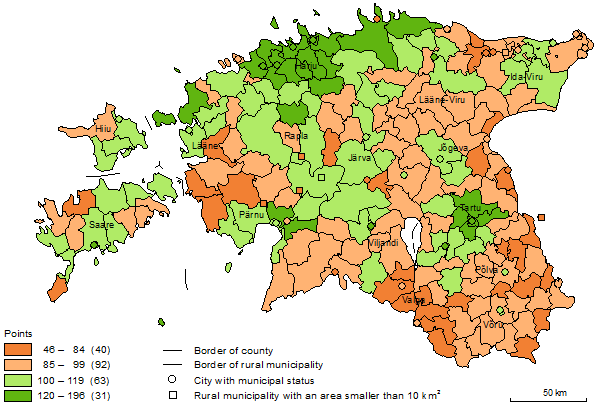The more people there are in a local government unit, the more viable it is? Not always!
The viability index confirms the gap between Tallinn and its vicinity, and the remote areas located further away from Tallinn. There is a positive relation between the population size and the viability index, but it is not a significant one – a bigger population alone will not guarantee a better result.
The first time that Statistics Estonia calculated and published the viability index of local government units was in 2004. The overviews of Estonia in 2004 and in 2013 are similar – more positive results are visible in Tallinn and its vicinity and on the Tallinn-Pärnu axis. More negative results were received in the region that is located on the Lake Peipus side of the Kunda-Ikla axis, where, as an exception, the area around Tartu forms a larger positive region. In Ida-Viru county, there is also a region that can be seen as rather positive. What can be highlighted as a more problematic area is the region which is formed by the northern part of Pärnu county and the southern part of Lääne county. A similar picture is characteristic of Estonia based on several indicators.
“If we ask, in terms of the viability index, whether local government units with a larger population are more viable, we can say that there is a positive relation between a bigger population size and a higher viability index, but this relation is not strong enough to claim that the bigger, the more viable,” noted Mihkel Servinski, Principal Analyst at Statistics Estonia.
Viability index on local government units, 2011

According to the viability index, the most viable rural municipality in Estonia is Viimsi. “This is relatively unsurprising and Viimsi can be proud of it. However, estimating the viability index is not about determining “the winner”,” Servinski said, and added that the task of regional statistics is to provide information that would enable local government units to analyse their strengths and weaknesses. “Perhaps the viability index performs this task with more zing than the eight indicators that are the components of the index would separately. According to Statistics Estonia, the index gives food for thought to both those at the top of the ranking and those at the bottom of it. There is no reason to pronounce the latter hopeless and also the former has fields that need developing,” Servinski explained.
The viability index is based on eight indicators: population change, the share of persons aged under 65 in total population, mean registered employment, receipts from personal income tax per capita, local government revenue per capita, the share of persons with higher education, the number of companies per 1,000 inhabitants, the number of economic activities of companies. The value of the index is not directly related to how the indicators ranked: the index value is in accordance with the value of the indicator.
The presentation of the publication Regional Development in Estonia 2013 to journalists will take place today, on 29 November, at 11:00–12:00 at Statistics Estonia (Tatari 51, 5th floor).